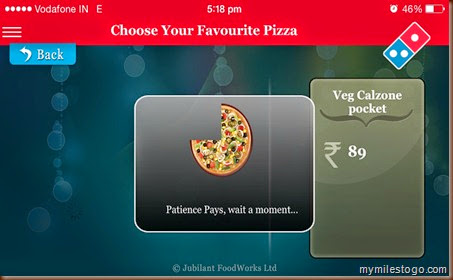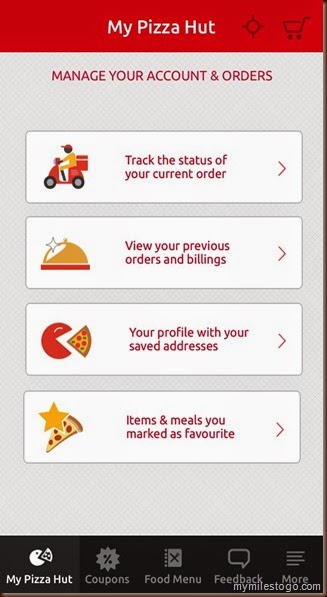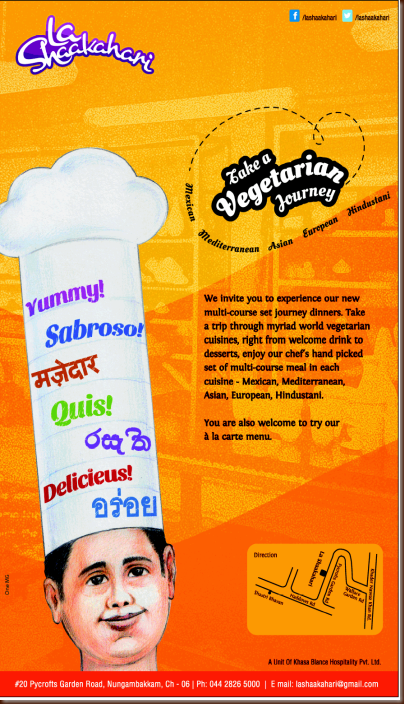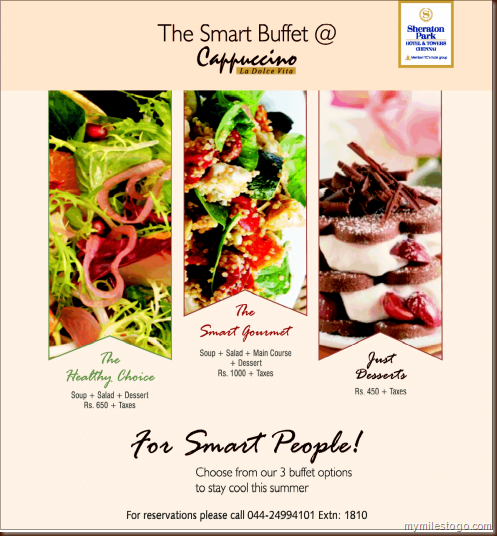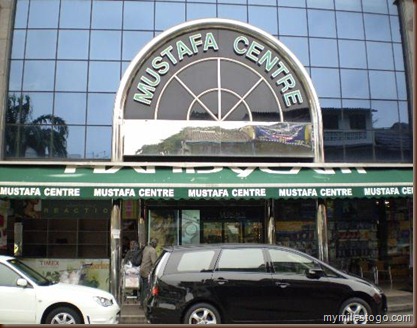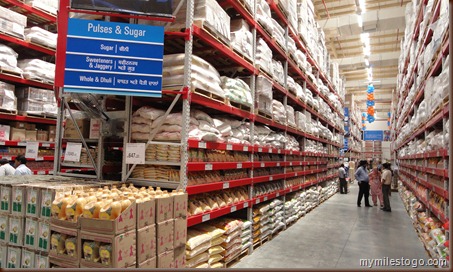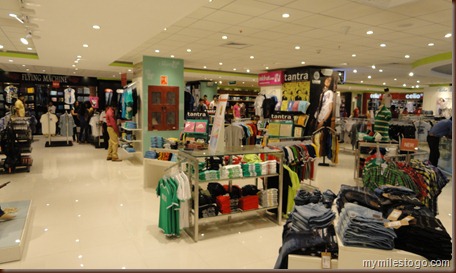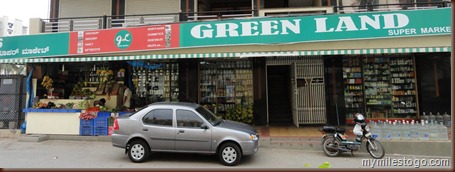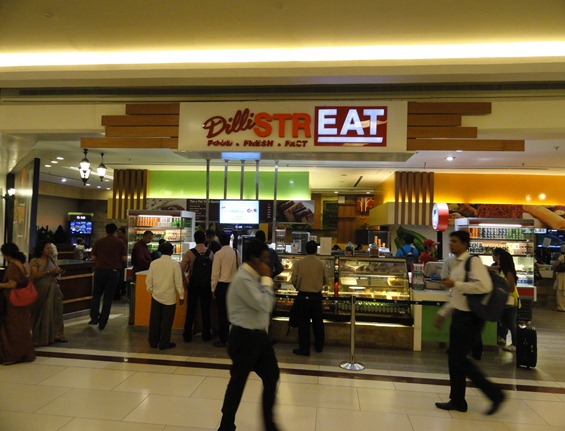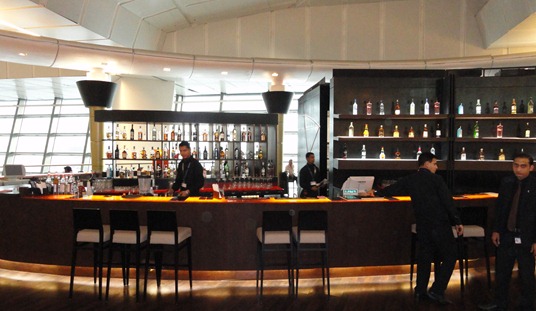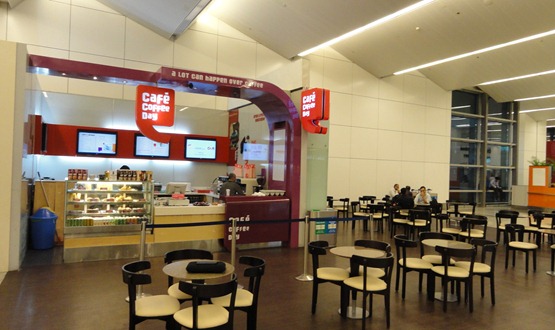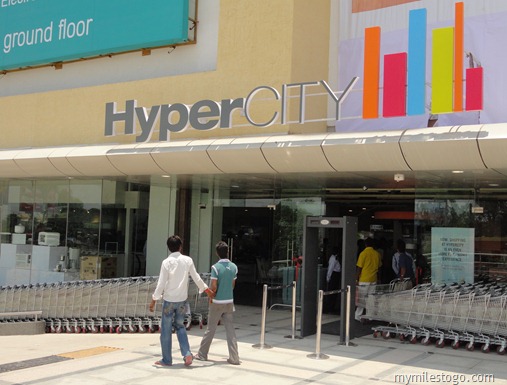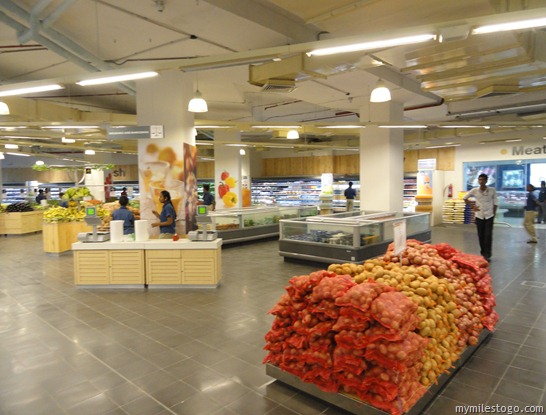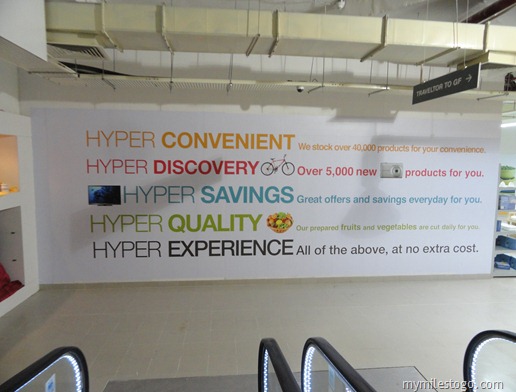01 July, 2015
Are Cafes sustainable?
31 October, 2014
Hate thread on McDonalds
24 July, 2014
Online Dining
I have enjoyed my pizzas better at the restaurant that at home, all along. It is more to do with the fun of dining – you plan a trip to the pizzeria, a walk or a short drive usually, or even at a Mall after finishing retail therapy. I fondly remember the bottomless Coke and unlimited Pizzas at Pizza Corner in Chennai in the late 90s during my most cherished college days with my gang of friends. Have ever since been a fan of pizzas and the love has only been growing. Frankly, I like pizzas from different places, be it Dominos or Pizza Hut, California Pizza Kitchen or standalone indie restaurants. One of my most favourite of course has been from “Italia”, the fine dine restaurant at The Park, Bangalore. For me, Pizza is an all time snack. I am usually game for a pizza at any time of the day (or evening) although I avoid a heavy dinner of pizzas. In fact, the love of pizza is more because of the yummy accompaniments, the cheese garlic bread and an array of toppings, especially the gherkins and olives. Am not a big fan of coloured flavoured colas and would rather prefer a strong coffee if not a lemon ice tea to drown the heavy food.
What I like best is food to be served hot and fresh from the kitchen. Haven’t been a big fan of home delivery or takeaways since I feel that the freshness is somehow lost, especially the international fare such as pastas, pizzas etc. although Indian food is still doable – we have an option to reheat the curries and biryanis at home once again which can’t be done with pizzas and pastas. Have avoided ordering pizzas at home for a long time now since I have had not-so-great experiences in the past, but that was probably because I used to live in Bangalore where the ambient temperature outside is not conducive to serve hot food by road.
This Football season, I decided to order pizzas at home. No, I don’t follow the game but why not enjoy the delicious offers provided by F&B Retailers! So, first it was Dominos followed by Pizza Hut. On the first occasion, the pizza arrived pretty late, almost 45 minutes since I ordered. I was very disappointed with all the promises made by the company on various media, but gave a benefit of doubt to the delivery boy – he must have had a lot of orders to fulfil and mine was probably the last one. So, I didn’t make an issue about it and just left it there. Yes, I would give them a try once again in future and I hope they live up to expectations.
On the next occasion, the pizzas were served hot and were in a consumable condition even after 20-30 minutes of being delivered at home. What was surprising was it was a Sunday and was the day of the “Final” match between the two teams. And yet, the pizzas were sent on time, well ahead of the promised time. They have a future customer for sure!
In both occasions, I used the mobile applications of both these companies. The UI for Dominos is a bit confusing while the one for Pizza Hut seemed much better. In fact, I had to switch over to the website while ordering for Dominos since that seemed to be a better option. The UI is perhaps not designed by retail experts and with consumer feedback, it lacks the sensibilities that customers look for, especially people of the older age and for women, both of these segments may not be very mobile savvy. Also, one of my friends quipped on his Facebook post recently how the delivery boys call a number of times to take directions. The Pizza companies can take a cue from Uber, the taxi service guys who have a GPS enabled map on their cell phones that help the drivers reach their destination without even calling once.
Mobile App Zomato also integrates Home Delivery along with providing reviews about restaurants and they are growing rapidly not just in India, but also internationally. Overall, I guess online dining, or rather online ordering is a great way to reach out to customers. It is also non-intrusive in a way. There is no need to call a number and go through the menu being repeated often – the menu is just there on the mobile app or on the website and helps users to choose what they want quickly and easily. Once customers are used to it, they would rather prefer this option instead of calling on the phone, whenever they desire to order food home. So, go ahead and try ordering on your phone next time. And yes, do take a minute to share your feedback. Happy Dining…
13 March, 2014
Food Retail is tuff…
Restaurant business is damn exciting. While people don’t shop for clothes and mobiles every weekend, most people drop over for a good meal frequently and a great meal, once in a while. Great Meal, I mean is a bit indulgent. It could be a Michelin rated restaurant. It could be one among the top 10 restaurants in the country. It could be a celebrity chef’s eating place. Ofcourse, the Five-Stars. The list is long. However, the food business is also one of the tuffest to be in. In fact, it is also one of the retail formats where the churn is very high. For every 6 successful restaurants, three of them fail. And the reasons for failure are aplenty, Customer Service (or the lack of it) being one of the main reasons why restaurants cannot keep up in the short to medium term. Also, investors are not too keen to fund ventures that do not show the ability to scale. 2-3 outlets is not scaling up. It should be in double digits. Most of the restaurant owners are entrepreneurs, many having chosen the route to entrepreneurship after stints in corporate life. They invest their life time savings to open a restaurant (also includes Pubs / Nighclubs / Others) and usually find the going tuff within 18-24 months of opening. That’s when the business matures and needs further investment in marketing and PR – the machinery that keeps restaurants going. I was at a restaurant called “Tangerine” in the upmarket Alwarpet locality in Chennai. The last I had been there was about a decade back. The food was excellent, just how I remember it had tasted during my last visit. However, the place was a bit worn down. The kitchen, which has limited space and equipment cannot cook more than two dishes at a time, which increases the waiting time for guests. The staff fare not all that excited, since they don’t get regular footfalls all over the week.
The business is all the more difficult if they operate in niche categories. In a city like Chennai, there is a strong thrust on Veg-only restaurants. Yes, you heard that right. In fact, India is the only country in the world which has so many veg-only restaurants and that too, all across the country. I visited one last month. It is called La Shakahari. La, being a french word and Shakahari being vegetarian in Hindi language. The restaurant is located inside a residential area and I was almost being challenged by the Google Map in my phone to find the place despite its best efforts. But once we entered, we realized what a great place it was. They had a set-menu as well as A la Carte. The set-menu offerred more items for what we would have paid otherwise while ordering them individually.
One of the biggest challenges that Restaurateurs face is the inability to scale-up. Most times, it’s the lack of capital. At times, it’s the lack of intent and interest to grow. A potential investor would indeed be able to show inclination to projects which are tried and tested. However, many entrepreneurs just don’t expand. Another option to scale up is the Franchising route. However, the risk is you would lose consistency in the long term and many of them would probably serve food that tastes different. For fear of not diluting their exclusive menu and taste that it offers, these restaurants remain standalone ventures and thus allow others to crop up in other parts of the city.
Of all retail formats, the F&B format is one of the toughest to operate. Many of them shut shop within 24 months of opening. If they withstand any further, then they strive to stay for a long time in their lifecycle. It also depends on the choice of real estate – Rent is almost 20% of Sales in Malls and about 12-15% at High Street locations. And that’s why you don’t find many of them in Malls not doing well or being priced exorbitantly. At the end of the day, the success of a restaurant is actually many factors playing in.
23 January, 2014
Dining experinces redefined

And then there are two large hotels which have over 25 rooms each, one being Hotel Vista Park where I stayed. These hotels also have restaurants and a small bar. To my utter surprise, there was literally no one in the in-house restaurants in the evenings. I would have expected the hotels to run a few schemes such as Happy Hours in the Bar or Food combos. But no. The staff were not bothered that guests were walking away to nearby restaurants. The Management seemed to be unaware as well.
So, are stand alone restaurants, pubs and cafes a threat to these Hotels? Indeed. To circumvent this kind of a spill over, Ginger Hotels, a part of The Tata Group had tied up with Cafe Coffee Day. The cafes of CCD are located within the premises of these hotels, usually in the lobby and would normally be open 24/7 and would even serve piping hot Cappuccinos and Sandwiches to the rooms. Most of the Ginger Hotels have these cafes. A few standalone hotels too have made such arrangements to attract non-resident guests and the public at large. In the West, it is common to see cafe chains such as Starbucks, illy, Costa, to name a few to have their cafes within smaller boutique/business hotels.
22 May, 2013
Inviting patrons for a great feast
The Hotel Industry in India is facing tough times ever since the global recession occurred a couple of years ago. In my current role at Royal Enfield as Head of Business Development, I travel atleast 2-3 days every week across the country. Whenever I try to book rooms in small and big cities, the room rates just surprises me. I was trying to look for rooms in Hyderabad for stay over the next few days and was surprised to find discounted rates at 5 star hotels for as low as Rs. 5000 (USD 90). The Leela and Grand Chola – both touted as 7 star rated properties in Chennai are offering over 40% discounts on printed rates, to as low as Rs. 7,000 (USD 130). Same is the case in Delhi, Gurgaon, Mumbai, Pune and is even worse in smaller towns. I stayed in Trichy, a city in central TamilNadu which connects a number of other towns of prominence in business and culture within a 100 km radius during the first week of May 2013. On the MakeMyTrip mobile app for the Apple iPhone, I could get a double room for three adults and two kids for as low as Rs. 2,500 (USD 55). The room was quite large to hold a King size bed and two single beds. I have stayed in cities like Coimbatore, Dehra Dun, Jammu, Patna and many others for similar rates in well maintained properties. The outlook for hospitality in India as such wears a glim look and with increasing inventory and competition, not to forget the choices that customers make, the pricing is aggressive at most of the properties. This is where ancillary income to Hotels are helping them.
Most of the hotels have in-house restaurants, mainly to cater to resident guests. Many of them advertise these restaurants quite heavily, thereby attracting visitors through the year irrespective of peak season or otherwise for room occupancy. While this practice has been there for long, its quite evident these days with a number of hotels including some premium Hotel chains advertising in the media. What caught my attention recently was an ad (displayed above), by ITC Hotels, one of India’s largest companies in the hospitality space for their Cappuccino Restaurant at the erstwhile Park Sheraton (in Chennai) . They have advertised buffet options with prices! Do those patrons who visit these places really care for the price? I mean – everyone does. But then, do people care what the final bill is gonna be when they visit star rated hotels and restaurants? I really doubt. Restaurant incomes are an important source of revenue for Hotels. They contribute anywhere between 7-25% of total sales depending on how well these restaurants are positioned and popularised. Some of the restaurants in these hotels are even Michelin-rated – a rating by the Vehicle Tyres powerhouse Michelin which grades eating joints across the world and shares in a report that is published annually.
Suggested Reading: Franchising
Stand-alone restaurants are doing their best too, to woo potential customers. They advertise in leading newspapers regularly to attract attention and over a period of time become destinations. In some cases, they are located within hotels and Malls and in many cases they are located on High Streets. User reviews in sites and apps such as Trip Advisor, Zomato, Burrp! etc. help them gain more traction. Chains like McDonalds, Pizza Hut, Subway and Café Coffee Day advertise across the media regularly to pull customers to their outlets and many of them even offer complimentary WiFi as a hook to retain them.
Suggested Reading: Does Free Wifi help?
With inflation leading to peak rates of food items, it is becoming impossible to middle class families to venture out eating outside. But the upper-middle class seems to be slightly more insulated, fuelling the needs of these restaurants. While premium hotels and restaurants promise great food (quality) and a wonderful ambience, consistency is key. To retain existing customers and to attract newer ones. If you are planning a visit to a nearby restaurant this weekend, flip through the pages of newspapers or mobile apps and you may be in for a surprise at a hotel nearby you! Happy Dining…
Suggested Reading: Food Inflation
25 January, 2012
Retail Store Opening Time
I recently received an email from Reliance Mart that they would opening their stores at 8am! The email newsletter was a bit incomplete in most respects – it doesn’t talk of its existing store timing (including opening and closing) and the list of all stores or a contact number such as a Customer Care number or a Toll Free number. It is anybody’s guess why this particular retailer would want to open so early – given that it is a Hypermarket format. In the footer of the communication, the cities where they operate is mentioned, most of which are non-Metro cities, which I guess could be the main reason for this move. In metro cities, people (Read: consumers) leave to work by 8am and return back around 8pm, hence most of the modern shopping environments including Malls, Supermarkets, Hypermarkets and Specialty Retailers open their stores only by 11am. Also, this is a huge cost-saving for retailers – lower usage of electricity and other utilities; staff can work in a single shift; most importantly, it provides time to set-up the store in the mornings – stock fulfillments, “facings” of products on the shelves and a sound briefing session to the staff.
At Foodworld, (a Supermaket chain part of the erstwhile RPG Retail) when I used to work in Chennai 10 years ago, we experimented opening the store at 7am – really early by Organized Retail standards. But what we realised was that we built a strong loyalty among the local residents and the neighborhood. Customers started coming in early to pick up vegetables that would have landed fresh at the store; and along with bought a packet of bread and some milk. And a few other daily use things too! I remember, we used to interact with regular customers and they would feel happy to be at the store so early! I guess this is one area where Kiranas cleverly take a lead amongst Organized Retailers. A typical kirana store opens by 7am and starts brisk business early. And closes as late as 10.30 or even 11pm at times.
The Government’s rules and regulations are not helping Organized Retailers either. Law states that women employees (who contribute to a significant percentage of the work force in the front-end of Organized Retail in India) cannot work beyond 9pm and should be escorted back home by the employer. Almost no one follows this though, thanks to lax overseeing by the respective agencies and authorities. The retail stores cannot function beyond a certain timeline, which is 8.30pm in Kolkata, 9.30 pm in Chennai and so on. Recently, Star Bazaar, part of TRENT Retail (owned by the TATAs) and Total Hypermarkets, part of Jubilant Retail based out of Bangalore extended their store closing time to 12.00 midnight, a welcome move by regular customers who heaved a sigh of relief since they could comfortably shop during the late hours! Mustafa, a local retail giant in Singapore, for example, is open all night and sees regular customer flow all through! I was told that the contribution of business between 9pm and 8am is almost 20% since tourists hop by after the city closes down.
With FDI in single brand retail already in place, it is anybody’s guess if more and more Retailers would want to keep the stores open late night or open early since the International Giants might want to pump in more money and experiment if customers walk in late at night. While this may work for certain categories such as grocery, household, furniture, etc. it may be obvious that fashion is not something that could work. After all, that category of customers would we wining, dining and partying late night than shopping! Café chains such as Café Coffee Day, Barista, Costa, etc. keep their outlets open until late in the night while book store chains such as Crossword and Odyssey usually wind up early. The case may be a bit different at Airports, where a majority of International Travel happens during the night and therefore, most of the Retailers are open all through the day and night.
There are a few advantages for Retailers to have extended store opening time;
- Customer Service – During the lean hours, Retailers can provide better customer service, a typical measure to increase conversions
- Loyalty – Retailers could offer bonus loyalty points (if they are operating such a program) to those who shop during such a stipulated time
- Understanding Consumer Behavior – Since customers would be shopping under a more relaxed environment, they may tend to show a better behavioral pattern which may be useful to Retailers
- Targeted Promotions – Retailers and Brands could run specific promotions during such times to increase penetration of certain SKUs
The drawbacks though, would be;
- Increased Operating Costs – Retailers would have to shell out additional salaries to staff who work during such extended times as well as incur other overheads
- Sustenance – Such a move, if it is experimental only for a short while can dent the brand image of the retailer among customers, leaving them confused
- Managing the network – If the Retailer has stores across multiple cities, then it may be forced to maintain uniformity across all locations
Having said that, I believe there are hardly few Retailers who would want to try this venture. For, success is not something that comes without repeated attempts!
06 January, 2012
End of Season! End of Party time?!?
Late 2009 was the time when one could see the slow down of the 2008 Economic slowdown in India. While rest of the world including America, Japan and parts of Europe were down with Recession (read: 2 Quarters of continued negative economic growth), India was seeing its GDP grow at a modest 7%. As Kishore Biyani, CEO Future Group once said in 2008, “Consumers are sitting on the fence, not really knowing when and what to spend”. How true, it was at that time. And then 2010 happened. Growth was the new buzz word and Retailers were back in action. New swanky stores, additional staffing, high-paid executives in the upper echelons and yes, a double digit same store sales growth which was being celebrated by one and all. All izzz well – the song from the movie “3 Idiots” was the most hummed song among the Retail fraternity thereafter for the next 18 months.
 Photo Courtesy: Times of India
Photo Courtesy: Times of India
Consumers who were holding on started buying new houses; furniture and furnishings for their new/old houses; Cars of all sizes – from an upgrade to a sedan to the first four-wheeler in the family; brown goods – LCDs and LEDs saw growth of over 100% for some brands! Refrigerators and Washing machines were flying off the shelves; Smartphones’ sales grew than those of normal phones; shoppers were buying more footwear and clothes, not just to show-off their wealth and happiness but because they could now afford to. Monthly grocery, which is an important metric to measure consumer confidence was growing at a healthy double digit. The confidence in consumer spending allowed Retailers and Brands to invest more and more – on new stores as well as higher targets. Unfortunately, the party seems to have ended abruptly.
(Suggested Reading: New Store Openings)
Lifestyle, India’s premier Department Store Chain was the first to announce EOSS – End of Season Sale last week. This came as a big surprise to the market – consumers aren’t complaining though. Central Malls, part of the Future Group and the largest mall chain in the country announced flash sales over the New Year Weekend, only to end up disappointing itself. Even brands like Levis which wait until Valentines announced “Sale” a day before. Spanish chain Zara, went on sale too, albeit it matches its International calendar where the end of season sale happens around Boxing Day and continues until Christmas. The new season in the West begins from January onwards. Most brands usually run on full price until Feb. 14, assuming shoppers would anyway buy, irrespective of the price-tag to fulfill their own wishes as that of their loved ones. This year seems to be an aberration.
Photo Courtesy: Times of India
“The targets for the current year were ridiculously high; We pleaded the Management not to set such high, unrealistic targets but they were in no mood to listen, thanks to the high voltage sales that have happened over the past 4 seasons” – says the Area Sales Manager of a premium apparel brand, who requested anonymity, saying he was not the official spokesperson. The Unit-Head of one of India’s largest Department store chains quipped that the chain has more stores today in large cities and hence the pie doesn’t seem to be growing rather getting cannibalized. “Instead of increasing the customer base of loyalty members through marketing activities and TV ads, the Management is getting into deep discounting; we had one of the finest customer service staff 4 years ago, but I cannot claim so now; they (the CSAs) are paid 6-7000 bucks and obviously the quality of staff and their service has deteriorated.” This gentleman, whom I’ve known for over seven years now requested I don’t mention his name as he may even lose his job for saying so.
(Suggested Reading: Customer Service by Trial & Error)
“These days, people are walking to our stores, checking out the products and then buying online. 5 years ago, the larger players were threatening our livelihood, but these days, looks like the online players will wipe us out”, quips Ravindra, shop assistant at a leading electronic store in Bangalore. “FDI in Retail is a big threat for us; if the big international players step up their expansion like what I’ve seen in the Gulf over the past 15 years (read: Middle East), then we will all have to shut shop and find an alternative full-time job rather than running these departmental stores”, cries Syed Pasha who settled in East Bangalore 5 years ago after working in Sharjah for 15 years as a low-cost laborer.
Photo Courtesy: Times of India
So, is the party over already? The answer is a big NO. Retailers and Brands have to realize that short-term growth is no metric for long-term survival. Nor would E-Commerce players like Indiaplaza.com would take away their share of business. India is a one trillion dollar economy and is fundamentally a strong one, with its ability for self-sustenance. (Sale) Targets are an important part of the business but they are not the only ones to focus on. Most Retailers and EBOs of Brands need to step up customer service. Rather than pay lower and have more staff, they should consider paying higher salaries, mostly linked to sales and have lower staff on the floor who are efficient and effective in their output.
(Suggested Reading: What retailers can learn from the aviation crisis)
The Retail India Story has just begun; Internet Commerce is still under-penetrated at the moment. Retailers can and should take advantage of growing consumerism with better service with fewer stores. As always, Small is Beautiful.
01 January, 2012
Retail in India–Way ahead for 2012
Organized Retail in India has come a long way over the past decade and 2011 was expected to change the wind towards the positive side, due to allowing FDI in Retail. Thanks to political unrest and the opposition parties claiming hoarse, FDI in Multi-Brand Retail has been put on hold (hope not shelved) while FDI in Single Brand Retail has quietly been allowed, atleast on paper. While a few International Brands such as Benetton, Tommy, Diesel, Esprit, etc. have been operating in India for many years now through Joint Ventures with Indian partners, a beeline of Brands wanting to enter India is expected in 2012 – a hope that many in Retail have been holding on for sometime now! The coming months are expected to be exciting times for our Industry and here’s a view on how this landscape would evolve;
Malls
From a lakh square feet to a million square feet in 10 years, modern shopping centers aka Malls have walked a long journey all these years. Today, Malls are not places for consumers to just shop but a generous mix of shopatainment – which includes Shopping, Dining and Entertainment. While there are over 200 operational malls today in the country, another equal number is expected to come up in the next few years. A number of mall projects which commenced during the slowdown in 2008 are ready for occupancy now and many are expected to launch this year.
Supermarkets
The neighborhood supermarkets have evolved the most, among all formats of Retail over the years. Size was always a concern for players like Spencer’s and More – getting it right was a challenge, either the stores being too big with empty shelves or too small with regular stock-outs. Many players have exited the marketplace while a few like Food Bazaar and Nilgiris (through franchises) are increasing their presence assuming scale-up would help them gain overall net margins which range in high single digits. This would be the first format, in my opinion that would straighten up – only serious players would exist and they would do a great job while many others would exit – hopefully this year.
Hypermarkets
With foreigner CEOs and advisors engaging the managements of Indian Retailers, it was widely believed that Hypermarkets must be large, really large like the ones in western countries.Thanks to some early learning, many players like Hypercity and Total have corrected their ways of working. Small is the new Big, with Hypers ranging from 20,000 – 45,000 in prime retail areas in multi-level locations compared to the earlier proposition of being over 60,000 sft – one single floor in suburban areas! Newer players especially multi-nationals like Tesco and Target are expected in this format in the coming year while existing players are planning massive scale-ups.
Department Stores
These large format stores, the blue-eyed ones due to their colorful appearance was and is expected to be the only ones to see some EBIDTA in their early years. That’s a boon and bane in a sense in this format. To ensure they attract high-spender footfalls regularly, they should turn their stocks quite often; that means having the right mix of merchandise is extremely important which is a direct impact of having high quality staff who can choose the right merchandise every consecutive season. This is a vicious cycle and players like Shoppers Stop, Lifestyle, Westside etc. have got it right while a few of them are still struggling to learn.
Specialty Retailers
Stand-alone specialty stores of international and even domestic brands are seeing dwindling numbers. The total number of stores that were being added year-on-year have reduced considerably. If it was 20 new stores and most being unprofitable four years ago, the numbers have reversed, thankfully. Most brands don’t talk about crazy numbers anymore, only well-merchandised stores and outlet level profitably.
QSRs and Food Retailing
It seems cooking and eating at home is a more expensive proposition these days thanks to high food inflation and going by the sales of pizza chains and fine-dine restaurants. While Dunkin Donuts is almost ready with its first outlet, Starbucks is slated to open quite soon too. Café Coffee Day will ad over 200 new cafes this year while Dominos and Pizza Hut will have company in California Pizza Kitchen and a few others. This would indeed be the most exciting format to watch indeed!
Kiranas
The unorganized retailer down the road doesn’t pay taxes or offer health benefits to employees; no one ever checks the quality or quantity of goods sold; BUT he is able to offer lower prices everyday to consumers with other additional benefits such as short-term credit and quick home delivery. Modernisation is the byword for the them and they are indeed giving a touch competition to the organized players.
E-Commerce
But the real competition, if not threat to all formats of retail in 2012 is going to be through E-Commerce. Sadly, many brands and retailers are not paying attention to the increasing internet user base – over 100 million as of 2011 compared to just three million in 2001. This has allowed fly-by-night operators to open websites that sell everything from toothpaste to watches, apparel to expensive jewelry! Most of them have no clue how e-commerce works and many are even buying merchandise and selling – something which goes against the fundamental philosophy of transacting online!
05 August, 2011
Spicejet and Indigo will help Retailers grow!
Photo courtesy: campaonindia.in
It was heartening to read that two of India’s low-cost airlines, Spicejet and IndiGo have ordered new aircraft. My former colleague and boss at BIAL Stephan Widrig, currently the Chief Commercial Officer at Zurich Airport used to say that world over, Aviation grows twice at the rate of national GDP. And rightfully so. Except for 2008-09 when India’s aviation landscape saw a slowdown, which was mostly a perceived threat to future incomes than any direct effect on current earnings, I guess we have been flying happily. The flight I just took, a Jet Lite from Delhi to Bangalore (low-cost identity of India’s premier airline Jet Aiways) was almost full,. When my ticket was booked a week ago, the return fare was around Rs. 11,000 (USD 230). Not bad, I would say. And almost all airlines are running full during the peak hours and the load factor on an average seems to be over 80% (no of seats filled per craft).
Spicejet was recently acquired by media baron Kalanithi Maran, who runs the Sun television network across the country. Though media and aviation have nothing much to do (atleast directly to spur each other’s growth), he would be the only person who would know the reason and logic behind entering a rather unknown industry. Having said that, he has been an excellent entrepreneur in his own right and has created a niche for himself in the media industry, in which his company controls over 70% of channels and viewership in Tamil Nadu, especially in South India. While he is known to be a media-shy person, he is also known for his aggressiveness in his business approach. So, when Spicejet announced expansion plans by acquiring new aircraft and applying for international routes, industry observes are not surprised. But his team and he are doing something rather differently. Instead of buying an Airbus or a Boeing, they have chosen to buy Bombardier aircraft. Except those in the industry, many wouldn’t know that aircraft which have lesser than 80 seats are exempt from various aviation and airport taxes in India. Most importantly, they don’t have to pay landing and parking charges at these airports. Since they have smaller aircraft sizes, they can easily land in smaller landing strips of 2,000 – 3,500 metres (Delhi has 4,200 metre long runway which is capable of handling the Airbus 380, the largest passenger plane currently). Many years back, Captain Gopinath, the pioneer of low-cost flying used the same to his advantage when he launched Air Deccan, India’s first low-cost airline by operating mostly ATRs to fly regional short-haul (less than 2 hour) routes. Similarly, Paramount Airways (which is now defunct and has severe debts) used Embraer aircraft and reaped benefits until such time they were alive. Sadly, both companies couldn’t sustain for too long due to investments and cash flows. Maran, hopefully shouldn’t have that issue.
Now, how does that help Retailers? Indeed, it does. Indigo and Spicejet have announced plans for International expansion. While Spicejet has chosen Hyderabad Airport as its hub, Indigo will use Delhi for expanding its base. Thanks to low-cost operations, both these airlines are expected to penetrate into Tier II towns. Smaller airports such as Raipur, Ranchi and Patna have demonstrated double-digit passenger growth over the past two years. Thanks to employment opportunities, youth from these cities are living and working in bigger cities like Mumbai, Delhi and Bangalore and fly down to their home-towns when required rather than spending days together in trains like in the good old times. Now – more the number of passengers, more the opportunity for commercial establishments. And that’s where Retailers are expected to benefit. For example, after successfully operating at Bangalore and Hyderabad airports for the past three years, HMSHost, the $8 Billion F&B Retailer has recently won 10 year contracts at Chandigarh and Lucknow! While their bid was aggressive and raised eyebrows among the Industry, the company seems to be unfazed, After all, they operate at most number of airport locations in the world as a company, and should know better than anyone else. With their knowledge and expertise, not only would they set the standard in these airports, but would also fulfil the passenger requirements to the best possible. TFS, a newly launched company 2 years ago now operates F&B concessions at Mumbai and Delhi airports (the two airports account for over 45% of aviation in India). Chennai and Kolkata airports which are undergoing modernisation by the state-owned Airports Authority of India are also expected to go the master concessionaire way!
Regional Airports like Trichy, Coimbatore, Mangalore, Nagpur, Pune, Ahmedabad, Bhubaneshwar and many more are expected to propel aviation growth over the nest few years. Not only would they feed domestic traffic, they would also encourage the ever-aspiring middle class to undertake their first foreign jaunts. Indigo is offering a return fare of Rs. 9,999 to Dubai or Singapore from Delhi. Add on another Rs. 5,000 or so from anywhere in India for a connecting Indigo flight and a foreign trip for a couple at less than Rs. 30,000 (excluding cost of stay which works out to be very cheap if one avails package deals). These low-cost carriers are indeed growing the market and this would only help Retail and F&B players who are currently operating, as well as intend to operate at airports. The F&B spend per pax is currently less than a dollar across Indian Airports – compare that with a pax spend (on F&B) across major airports in the world such as Dubai, Singapore, Heathrow, Zurich which ranges from $5 – $15. More so, the low-cost airlines do not provide F&B on-board, so that is another opportunity that the F&B Retailers can capture.
Indeed, there is a long way to go for Travel Retailers in India and yes, it is expected to be a bumpy ride, thanks partially to lack of basic infrastructure requirements and trained manpower, but atleast there is a start that’s in the anvil. It’s up to the Retailers to identify and chase the opportunities and the to make the most out of them.
24 July, 2011
Retail staffing has a long way to go!
photo courtesy moodiereport.com
It was rather annoying that I didn’t get a refill lead for my Mont Blanc Pencil at the flagship store of the brand at the iconic UB City in Bangalore. The Sales staff, who was amicable and friendly ensured that the Mont Blanc service levels (as is globally) are maintained. What she didn’t do (and possibly, inadvertently) was accuracy of her technical skills. When I visited the store again the next day, another staff who was equally amicable and friendly explained that there were already spare leads within the writing instrument and that there was a mechanical issue due to which it wasn’t working properly. After a few permutation and combinations, he somehow managed to make it work! Well, I was impressed that my pencil was working normally but certainly not about the service levels at a store of one of the most respected brands in the world. In both the cases, there were no efforts made by the staff to show something new within the store – the interactions revolved around just fixing the problem rather being engaging or exhaustive.
A few days ago, we went for dinner in a large group to a reputed restaurant in town, named Aangan. I believe they have a few branches across the city and was proven to be a good place all along. even as we were walking towards the store, what I saw from outside made me a bit confused – such a respected restaurant was running fans instead of air-conditioning! Yes, I agree the weather outside is rather pleasant but the overall ambience inside wasn’t so, with all the odour of food. We placed the order and were sipping our soup and the staff was already there with the main course – rotis, dal, etc. When I questioned what was the hurry, the staff replied (but politely), that “the food was already prepared”. Then a senior guy came across and took the food back (though not to the kitchen but to another table!).
photo courtesy wsj.com
Now let me compare these with an example of extraordinary product / service orientation by Retail Sales staff.
WSJ.com recently carried an interesting article on how Apple has ensured highest levels of customer service at its flagship stores. More people now visit Apple's 326 stores in a single quarter than the 60 million who visited Walt Disney Co.'s four biggest theme parks last year, according to data from Apple and the Themed Entertainment Association. Apple's annual retail sales per square foot have soared to $4,406—excluding online sales, according to investment bank Needham & Co. Add in online sales, which include iTunes, and the number jumps to $5,914. That's far higher than the sales per square foot and online sales of jeweler Tiffany & Co. ($3,070), luxury retailer Coach Inc. ($1,776), and electronics retailer Best Buy Co. ($880), according to estimates. According to several employees and training manuals, sales associates are taught an unusual sales philosophy: not to sell, but rather to help customers solve problems.
Retail staffing is one of the most complex challenges that Indian Retailers have been facing over the years. My first employer, RPG Retail had set-up RIRM – RPG Institute of Retail Management, an inhouse training & development agency in which I was a Certified Trainer. The HR Team would scout for talent from government schools and recruit them as trainees – they would be provided class room training initially and later, on-the-job training at one of its Foodworld, Musicworld and Health & Glow stores. In addition to this, they would be given a Certificate after a 6 month period of experience and a job offer to join as a full time employee. The success rate used to be over 80%, thanks to the reasonably lucrative and respectful employment that the trainees used to get. Over a period of time, they were “ready to poach” variety for newer Retailers who entered the market. Most Retailers in India today have a Training & Development Department but it’s quite a challenge to retain front-end employees especially, thanks to the lure for a small hike in salary! Most of them do not have long-term goals and hence keep jumping jobs, partially for the sake of salary and partially for other conveniences – such as proximity to their residence, designation, and not to mention shorter working hours or lower work-load.
Thankfully, Indian customers at the moment are not as demanding as their western counterparts, but it is just a matter of time that they too shall be demanding superior product knowledge and high levels of customer service – from boutique stores to hypermarkets. Needless to say, retail employees would also understand this themselves, with personal experiences. More than the employers’ interest, I foresee employees (in the front-end) taking a lot more interest in training themselves – for their own long-term success and existence!
31 May, 2011
Hypermarkets–The latest poster boy of Modern Retail
The first thought that came to my mind was – “Will this store be THE game changer for this Mall?” Not that it had weak anchors otherwise, but somehow this store, I believe would attract most number of footfalls. Time will prove, and I hope my assessment would be correct in this case too. I am referring to HyperCITY from the K Raheja Group which opened a few weeks back at Royal Meenakshi Mall - Hulimavu, a lesser known suburb in South-East Bangalore which houses one of the largest new-age residential settlements of those who are employed in IT, ITES and the BPO Industries, mainly due to the cost effective availability of housing requirements as well as reasonable accessibility in terms of time and distance to their respective workplaces. A maiden attempt by a group of enterprising entrepreneurs, I would say this is another brilliant model for Neighbourhood malls – self sustained with most aspects of modern retail within its precincts. Other anchors include Cineapolis, the Mexico based multiplex chain with its first cinema in South India, CROMA – the electronics store from Tata Retail (TRENT) and many others.
The store is located on the upper ground floor facing the main entrance and the lower ground floor of the mall with direct access to the basement parking areas – a smart move by the Retailer to encourage shoppers to enter the store directly after they park their vehicles. However, after finishing their shopping from the Upper ground floor, one would have to pass through the lower floor to access their cars – a bit of walking around the store though, which could be inconvenient during peak shopping hours. The store is well laid out – the lower ground floor offers Grocery and other Home needs while the upper ground floor with all other categories including Electronics, Toys, Apparel, Furniture, even Bicycles and many more. My guess is that the lower ground would remain more crowded – for two reasons; one that it has brilliant view from outside and would naturally attract mall visitors, and two that it houses the core categories which shoppers would come looking to save for – grocery, fruits and vegetables and household items. What I liked the most was the “fresh section” – Maybe it was the first day and hence everything looked very nicely displayed but still, the way the categories were planned was commendable. Also, they are located deep within the store, another smart idea to pull customers inside and thereby making them walk through the store. Meat & Poultry located close by could prove to be a disadvantage if the exhausts and HVAC are not maintained well – an issue that many retailers are trying to grope with.
The store interiors are typical of a Hyper – no false roofing, basic tiles on the floor, tube-lights running through the length and breadth of the store and focus lights on merchandise that’s on offer. While it does reduce the Capex to a large extent, it also showcases the store as being simple and straightforward – a stark contrast to the luxury stores at high-end malls that sometimes stink of grandeur and austerity! After all, hypermarkets should also look what they profess – savings, savings and savings. And HyperCITY is indeed very good at it. On the store launch, Mark Ashman, CEO, HyperCity Retail (India) Ltd, told the media, “HyperCity is committed to fulfilling the aspirations of the local people by providing them a world-class shopping experience. Our customers will enjoy the convenience of international shopping from over 44,000 products at great value under one roof.” And all this over a mere 60,000 sft.!
With their continued focus on convenience, experience, quality and savings, there is something that this Retailer has been doing right. Apart from stacking the right merchandise, I guess its the speed at which they have been growing. Often accused (not in a real sense though) of being slow in terms of store expansion and growth, HyperCITY has got its act right. With only 10 stores across the country, the group has managed to understand the business well – they have opened at interesting catchments across cities to ensure that they are not just in the race to grab market share but also to make money at the store level. With an investment of upto INR 2 Crores per store, the Retailer has been cautious about its overall Operational profitability which seems to be getting better by the day. Specific to this Mall, none other than the Hyper is going to be the the main anchor that would attract thousands of shoppers every month! Those who come to shop would indeed pass through the other Retail stores, Food Courts & Restaurants and m\Movies would complete the entertainment bit as well. This store is not an exception, but Hypers would become the Poster boy of Modern Retail and the Darling of Mall Developers soon.
04 April, 2011
David vs. Goliath – Retailers and Kiranas. Long Live David.
A Firefly finally takes off
Monday - 22 Jan. ‘24 is a very important day in my professional life. I complete eight months today in my role as Executive Vice President a...

-
12 December is celebrated annually as Retail Employees Day, an occasion to thank the frontend staff who have taken up Retail as their pref...
-
The world is split into two for the last week or so, ever since India’s self-made billionaire and tech mogul Mr. Narayana Murthy (NRN) said ...
-
It’s been over 5 months since I wrote anything on this blog, especially. Not that I didn’t have anything to observe, even better to share my...





